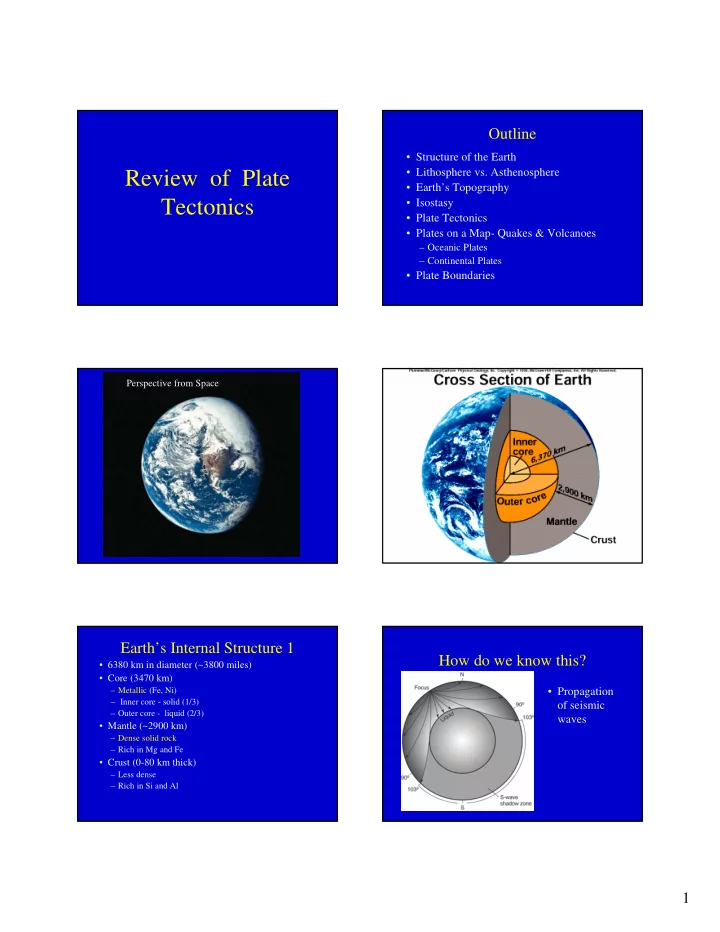

Outline • Structure of the Earth • Lithosphere vs. Asthenosphere Review of Plate • Earth’s Topography Tectonics • Isostasy • Plate Tectonics • Plates on a Map- Quakes & Volcanoes – Oceanic Plates – Continental Plates • Plate Boundaries Perspective from Space Earth’s Internal Structure 1 How do we know this? • 6380 km in diameter (~3800 miles) • Core (3470 km) • Propagation – Metallic (Fe, Ni) – Inner core - solid (1/3) of seismic – Outer core - liquid (2/3) waves • Mantle (~2900 km) – Dense solid rock – Rich in Mg and Fe • Crust (0-80 km thick) – Less dense – Rich in Si and Al 1
Velocity (km/sec) What are the Plates? Seismic • Lithosphere Velocity – Crust + Uppermost Mantle Profile of – Rigid (tectonic plates) • Asthenosphere Earth – Weak part of the upper Mantle Asthenosphere • Mechanical boundary layer • Zone of weakness • Seismic low-velocity zone • Zone of partial melting (2-4% melt) • Its depth is controlled by Temperature (1300 deg C) • Allows the plates to slide over it Lithosphere/Asthenosphere Ocean Basins vs. Continents 2
Percent area at each elevation, or higher Continental vs. Oceanic crust • Light (2650 kg/m 3 ) • Dense (2850 kg/ m 3 ) • Granite • Basalt • High elevation • Low elevation • Not so strong • Strong • Can be very old • Young • Lasts for ever • Gets recycled • Complex • Simple • Moves passively • Drives plate motions Isostasy Isostasy • The crust “floats” in the mantle • Each column of rock will have the same • Like blocks of wood of different density in mass down to the depth of compensation a bathtub • High topography is compensated by thick crust beneath Two columns of equal total mass Is the mantle really weak? ρ ρ h h • Continent under the load of a glacier 6 km * 1000 9 km * 2850 2700 * 30km + + 85 km * 3300 3300 * 70km 3.12 x10 8 kg/m 2 3.12 x10 8 kg/m 2 ρ =density= kg/m 3 3
The plates: Distribution of Earthquakes Seafloor Spreading 1 Seafloor Spreading • Mantle convects at 1 cm/yr • Continents are carried passively • Rising convection at mid-ocean ridges • Their leading edges are strongly deformed – Mantle material comes to the surface at ridges • Oceanic sediments and seamounts get plastered against the continents • Sinking at the trenches • Oceanic basins are impermanent, continents • The whole ocean is swept clean every 250 are permanent to 300 million years • The earth is a dynamic body, its surface • Continents can rift apart to produce new always changing. mid-ocean ridges The ocean floor is a tape recorder Magnetic Polarity Reversals 4
The other side of the story: Subduction • The Earth is not expanding • Old ocean crust sinks into the mantle at the trenches • Earthquakes show us where the slabs are • Volcanoes form at subduction zones Subduction Zone What causes the Plates to move? 5
Plate Motions What causes the Plates to move? Plate Boundaries All Plate Motions are Rotations • Divergent (plates move apart) • Convergent (plates move together) • Transform (plates move past each other) v= r i sin Θ Motion with respect to what? Plate Tectonics and Structural Environments Divergent • Plate Boundaries Boundaries – Divergent – Convergent – Transform • Structural Environments – Extensional – Compressional – Strike-slip – Passive 6
Divergent Boundaries= Extensional Structural Mid Ocean Environment Ridges • State of Stress- extensional • Processes- Thinning and stretching of the crust • Types of Structures- rifts, normal faults • Examples- mid-ocean rifts, Basin and Range, East Africa Rift Normal Faults Normal Faults 7
Basin and Range Faulting Basin and Range Province Active mountain. front, Basin and Range Province, Nevada Convergent Boundaries= Compressional Structural Environment • State of Stress- compression • Processes- Thickening and shortening of the crust • Types of Structures- Fold and thrust belts, big Convergent Boundary mountains • Examples- Andes, Himalayas, parts of the Rocky Mts. 8
The Appalachians Canadian Rockies The Appalachians Continental Collision 9
Collisional Boundary The Himalayas Transform Boundaries= Mount Everest Strike-slip Structural Environment • State of Stress- horizontal shear • Processes- shearing • Types of Structures- transform faults, major strike-slip faults, (also normal and thrust) • Examples- San Andreas fault, Alpine fault (NZ), Anatolian fault (Turkey) • Transform Boundary • The most famous fault 10
San Francisco Bay San Andreas Fault • Transform Animation Oceanic Transform Fault 11
Transforms Link other types of plate boundaries. They may grow, shrink or be stable. What type of plate boundary is Passive Margin there along the US East coast? Continental Growth Continental Growth • Material plastered onto the continents at convergent boundaries • Example: – Everything west of Nevada has been added to North America in last 700 Ma 12
Continental Collision End 13
Recommend
More recommend